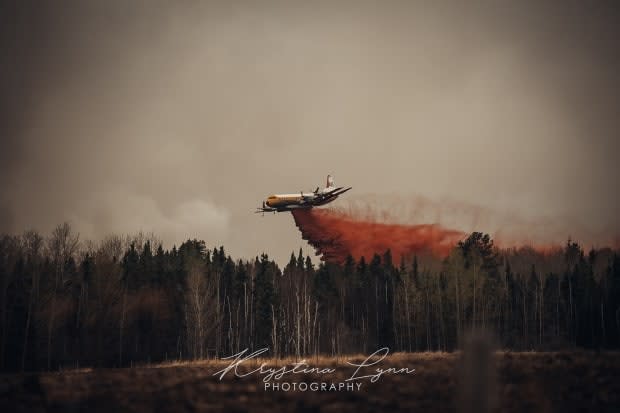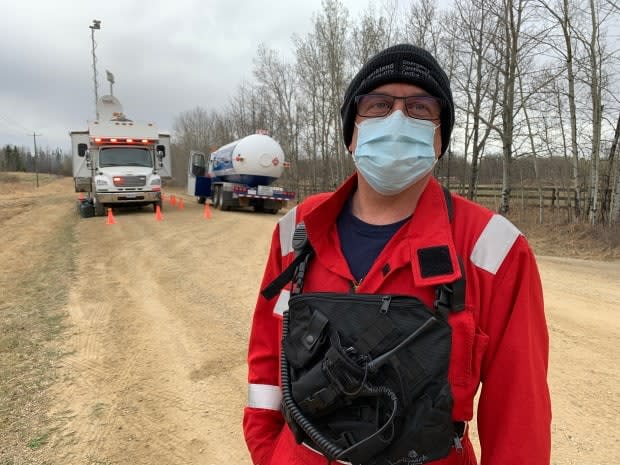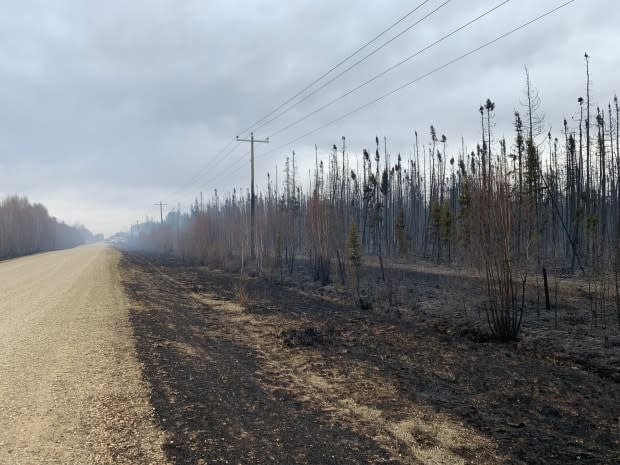Rain expected to help in fight against fast-moving wildfire west of Edmonton

Rain is expected to give firefighters the upper hand on a fast-moving Alberta wildfire that has destroyed more than 1,000 hectares of land and triggered evacuation orders in areas west of Edmonton.
Residents who live near in or near the hamlet of Tomahawk in Parkland County, about 100 kilometres west of the capital, have been ordered to leave their homes.
Mandatory evacuation orders were issued for parts of the area Thursday evening. The evacuation zone expanded overnight due to high winds.
The most recent critical alert issued says the evacuation area is now defined by Highway 22 to the west, Township Road 524 to the north, Range Road 63 to the east and Township Road 510 to the south. Anyone in the area must leave immediately.
In a statement issued shortly after 9 a.m. Friday, Parkland County said the fire is expected to be contained by nightfall due to the forecasted rain, with Environment Canada saying as much as 15 millimetres is expected in the region overnight.
The county said the fire has covered at least 1,000 hectares or roughly 2,500 acres.
Fire could smoulder for weeks
Parkland County fire chief Brian Cornforth said conditions are tinder dry and the winds remain unforgiving. While rain would help, he cautioned that the forecast has proven unpredictable.
"We had a good forecast for rain yesterday, but it keeps getting diminished," he said. "We need several millimetres of rain to make a difference."

Even if the forecast remains in their favour, Cornforth expects the fire to smoulder for weeks.
The area is riddled with peat bogs where fire can burn deep underground, even in damp conditions.
"The fire is going to sit in that ground for a long time," Cornforth said in an interview from the scene.
"We're going to be here for a week or two."
Cornforth said 20 additional firefighting crews have been dispatched to the scene, along with air tankers and three helicopters used in aerial firefighting, and a bulldozer crew that digs for hotspots and monitors potential flare ups.
At least 45 people have been forced from their homes, but he said that number is expected to grow as more evacuees register. All evacuees are required to register — in-person or by phone — at a reception centre set up at the district sports arena in Tomahawk.

Cornforth said conditions remain unsafe and urged residents to stay out of the evacuation zone.
"People may not see fire at their door," he said. "We need to evacuate you because we can anticipate where that fire is going to go. And last night was a great example of how fast that fire went.
"We literally drove up the driveway, told people to leave and the fire was at the door when they were packing their house out, so we need people to co-operate with us on that."
Waiting for evacuation orders
Krystina Lynn Kowalik, who lives on the edge of the evacuation zone, watched the fire burn from her 300 acre property.
She and her husband, Dan, were driving into town Thursday afternoon when they noticed a puff of smoke on the skyline. Then Kowalik got a call from her neighbour telling her to turn around because their home was under threat.
They returned home to their dogs and horses, packed up a few belongings and waited at the end of their driveway for evacuation orders to come. But they never did.
The couple didn't have to leave, but they spent a fitful night worried about their land and their neighbours.
"We could still see the glow of two hot spots in the distance," she said.
"I'm terrified to think of the homes that have been lost and the livestock and whatever that didn't get out."
Kowalik said the community has come together and people in need of a place to sleep have been taken in. Others spent the night driving around in their livestock trucks, helping people save their horses and cattle from danger.
"We're out of harm's way at this point unless the wind changes direction," she said.

 Yahoo Movies
Yahoo Movies 